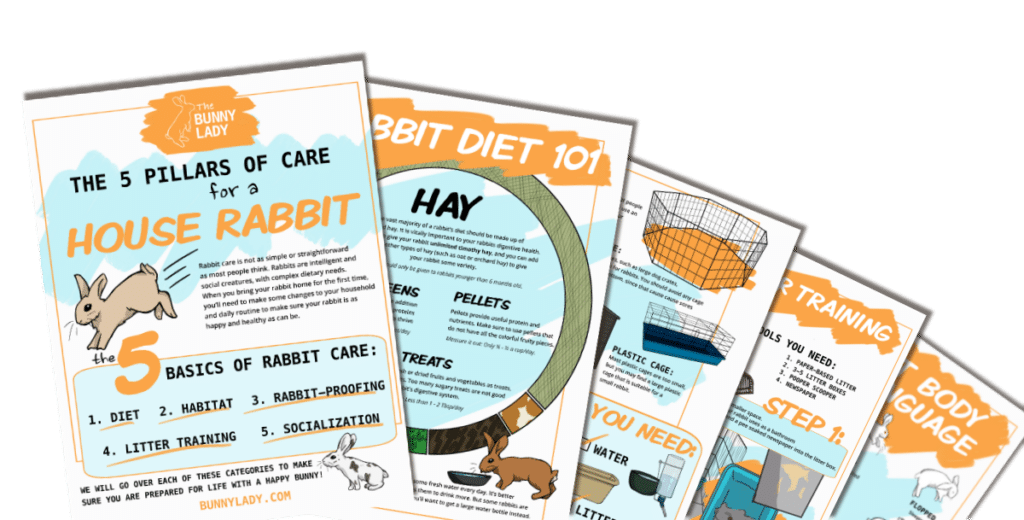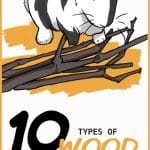Rabbits love to chew on things. You can give your rabbit a multitude of fun toys to keep their chomping teeth busy, and sometimes they’ll decide to go after our furniture or baseboards too.
However, just because rabbits like to chew on anything they can get their teeth on, doesn’t mean they should. There are some types of wood that are toxic to rabbits and other types that need to be dried before they can be given to rabbits. Wooden furniture that has been painted or varnished should also be avoided. Take a minute to learn about the common types of wood that are safe for rabbits to chew on.
Important: This page may contain affiliate links. As an Amazon Associate and an associate to other companies I earn a small commission from qualifying purchases.
Types of Safe wood for Rabbits
Rabbits will all have their favorite types of branches and twigs. Different types of wood taste different, so if your rabbit doesn’t like to chew on one variety, try another. It’s also a good idea to check what type of material your furniture is made out of, so you can be sure the type of wood is safe if your rabbit chews on it.

1. Birch and poplar
Rabbits can eat birch and poplar branches and twigs fresh from the tree. They don’t have to be dried. They may even like to munch on the leaves too. You can also construct furniture or enclosure accessories out of birch and poplar woods. These can be sturdy but also safe for rabbits.
2. Rose bushes
Twigs, branches, and leaves from rose bushes are completely safe for rabbits to chew on. You don’t even need to remove the thorns, rabbits don’t seem to mind at all. Many rabbits will enjoy eating rose flowers too. You can give them rose petals as a yummy snack every once in a while.
3. Kiln-dried pine
Pine that has undergone a certain drying process is safe for rabbits to chew on. This generally means that planks and furniture made with pine are fine, but not pine shavings or pine-based litters. You also want to avoid any fresh pine since this contains phenols that can cause liver damage in rabbits. If the pinewood still has that strong pine scent, then you want to stay away from it and opt for a different type of wood.
Similarly, pine cones are safe for rabbits but only after they have been thoroughly dried. You can purchase pine cones as toys for rabbits that have already been dried completely, but you can also bring them in from your yard. Just be sure to wash them and then set them out to dry for a week. If you want to be extra sure that the pinecone is thoroughly dried out, you can also put them in the oven at low heat for an hour or two.

4. Willow
Willow is a common material for rabbit toys. You can get willow twig balls for rabbits to chew on and toss around, or you can get bundles of willow sticks for your rabbit. You can also get wicker baskets and furniture that are made from willow. Just be sure that these are untreated if you want to give them to your rabbit to chew on.
5. Apple and pear
Apple and pear trees are safe for rabbits. They can have twigs, branches, or leaves fresh from a tree if you have one in your yard. Apple sticks can be commonly bought in bundles to give to rabbits. They often have a distinct flavor, making them a favorite toy among many rabbits.

6. Raspberry and blackberry bushes
Branches, twigs, leaves, and even fruit from raspberry and blackberry bushes are safe for rabbits to chew and eat. If you have any of these bushes in your backyard, you can cut a few twigs off and give them to your rabbit fresh. Just be sure to wash them first.
7. Kiln-dried aspen
Aspen is generally the most recommended wood to use as a litter material for rabbits since it is absorptive and controls odors. These shavings are kiln-dried, produced in a way that makes them safe for rabbits. Pine and cedar shavings are commonly sold as litter, but they should be avoided since they can cause liver problems.
Aspen should not be given to rabbits fresh from the tree though. This type of wood contains phenols that are toxic to rabbits when fresh. It’s best not to give this to rabbits unless it has been kiln-dried.
8. Maple
Some bunny-safe toys that are sold online and in pet stores are made of maple. They are also sold in bundles of sticks for your rabbit. This is a slightly sweeter wood, making it a more tempting type of chew toy for most rabbits. It’s also a safe wood to use for furniture as long as there isn’t any extra paint or toxic varnish.
9. Cottonwood
This type of wood is safe for rabbits as well as all other parts of the plant. This also means that it is safe to give your rabbit a blanket that is made from 100% cotton materials. Some rabbits like to chew and tunnel under blankets, so it’s good to know that cotton is safe for them.
What to do before giving your rabbit a branch or twig from outside
Before going outside to grab some branches for your rabbit to munch on, you should take some precautions. Branches that are outside could be harboring bugs or they may have been sprayed with harmful chemicals or pesticides.
- First make sure the type of branch, twig, and leaves you pick is safe for your rabbit to have fresh. Some tree branches are only safe for rabbits if they have been left to dry out completely for a number of days. Pinecones are also only safe to give rabbits after they have been dried out.
- Be sure to pick a branch that is not near a polluted area and has not been sprayed with dangerous chemicals. It’s best to use branches that are not near a road to avoid potential pollution from car fumes as well.
- Take your branch and wash it. If it’s a small branch you can use the kitchen sink and wash it similar to how you would wash your fruits and vegetables. You can also use the shower hose if you have a larger branch. Your branch can have leaves, or remove them if you want.
- Give it to your rabbit to enjoy.
If you live in an area where there is a current outbreak of the RHDV2 virus, it’s best to not give them any branches from outside. Find out more about the RHDV2 virus in your area at The House Rabbit Society.
Sources:
- Bergstrøm, Camilla. “Feeding the house rabbit 6: twigs and branches.” Medirabbit.com. http://www.medirabbit.com/EN/GI_diseases/Food/Branch/Branch_en.htm.
- Harriman, Marinell. “Literboxes and Liver Disease.” House Rabbit Society. https://rabbit.org/journal/1/liver-disease.html.
Tips and Tricks Newsletter
If you are new to caring for rabbits, check out the Bunny Lady bimonthly newsletter. Right after you sign up, you’ll receive a FREE pdf rabbit care guidebook. I put together a guide that goes over all the basics of rabbit care so you have it all in one place. Then you will receive tips and tricks about rabbit care straight to your inbox so that you know you’ll be taking excellent care of your new rabbit.
Recommended Products and Brands
Important: These are Affiliate links. As an associate to Amazon, Small Pet Select, and Chewy.com, I may receive a small commission from qualifying purchases.
The two brands that I use when buying food for my rabbit are Oxbow and Small Pet Select. These both have high quality rabbit products and are companies that care about the health of our small animals. If you are purchasing anything from Small Pet Select use the code BUNNYLADY at checkout to get 15% off your first order.
- Hay: Second Cutting Timothy Hay from Small Pet Select
- Pellets: Oxbow Garden Select Food for Rabbits
- Treats: Oxbow Simple Rewards
- Toys: Small Pet Select Natural Toys
- Enclosure/cage:A rabbit exercise pen
- Rabbit carrier:SleepyPod Mobile Pet Bed



